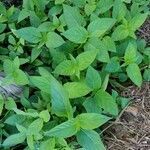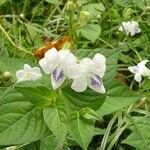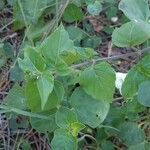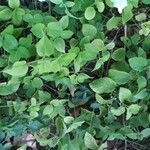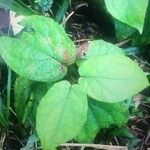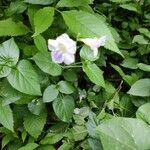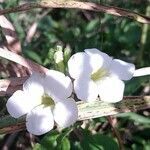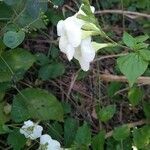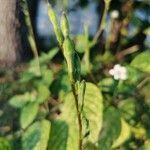Shrub or subshrub to 1.5 m tall, creeping or climbing. Branches ± quadrangular, sometimes furrowed on both sides, often constricted above nodes, these pubescent, glabrate or pubescent with trichomes disposed in decussating lines. Petiole 2-30 mm long; blade ovate, 15-45(-90) x 5-30(-50) mm, apex abruptly acuminate, truncate at base, glabrous or minutely pubescent on upper surface, minutely and sparingly pubescent on primary and secondary veins on lower surface, margin ± entire to shallowly erose; leaves subtending peduncles reduced, narrower than cauline leaves. Inflorescence an axillary or terminal, often secund raceme, 4-10(-20) cm long; peduncle to 5.5 cm long; bracts in opposite pairs on either side of peduncle, triangular, 0.8-2 x 0.75-1.5 mm, pubescent with eglandular trichomes on outer midrib and margins; bracteoles similar to bracts but smaller. Flowers single at nodes, sparse; pedicel 0.5-1.5 mm long. Calyx 5-10 mm long, glabrous or pubescent without, with glandular and eglandular trichomes; corolla blue, mauve or white, appearing yellowish when dry, 30-40 mm long, inconspicuously puberulous without, with glandular and eglandular trichomes, tube and throat 15-20 mm long, tube half the length of throat, throat 13 mm wide, lobes rounded, 8.5-15 mm in diameter, conspicuously and coarsely reticulate veined; stamens ± equal, each pair arising 3.5-4 mm above base, free for about 4 mm, filaments near base with 2 lines of trichomes; thecae sparsely eglandular and glandular pubescent dorsally just above base; ovary pubescent, style 14-16 mm long, basally pubescent. Capsule 20-25 mm long, pubescent, retinacula 2 in each valve, often 1 and its seed not developed fully; seeds 4 x 4 mm, smooth on sides.
Herbs, ascending to ca. 30 cm; stems quadrangular, pilose. Leaves ovate to deltoid, to 5 cm long and 3.5 cm wide, apically acuminate, basally obtuse to truncate, both surfaces glabrate to sparingly pilose, especially on the veins, numerous cystoliths visible only on the upper surface, the margins crenulate to entire. Inflorescences in terminal, mostly secund racemes, to 16 cm long. Flowers on short pedicels ca. 2 mm long, yellow with purplish throats; 4 bractlets in 2 series subtending each flower, small, to 2 mm long, lanceolate, pilose; calyx and pedicel pilose and with numerous glandular hairs, the calyx lobes lanceolate, 5-7 mm long; corolla to 4 cm long, funnelform, the lower portion of the tube to 3.5 mm wide, 10 mm wide at the throat, the lobes semiorbiculate, ca. 10 mm wide, with numerous, minute, glandular hairs without, glabrous within; stamens 4, didynamous, included, the anthers 2-celled, each cell mucronulate both apically and basally, 3 mm long, 1 mm wide; ovary 3.5 mm long, the style velutinous 21 mm long, the stigma 2-lobed. Capsule oblong, to 13 mm long and 2 mm wide; seeds 2-4, flat, oval, ca. 1 mm long and 0.75 mm wide, oblique at the point of attachment, edged with dense mucilaginous hairs when wet.
Herbs to 0.5 m tall, ascending. Stems 4-angled, pilose. Petiole 3-5 mm, pubescent; leaf blade ovate to elliptic, 3-12 × 1-5 cm, glabrous or sparsely pilose especially on veins, adaxially with numerous cystoliths, base truncate to rounded, margin entire or slightly crenulate, apex acuminate. Racemes axillary or terminal, to 16 cm; bracts triangular, ca. 5 mm, pilose; bracteoles linear-lanceolate, 1-2.5 mm, pilose. Pedicel 2-3 mm, pilose. Calyx ca. 7 mm; lobes linear-lanceolate, 5-7 × 1-1.2 mm, outside glandular pilose, margin ciliate. Corolla yellow or white, 1.2-3.5 cm, outside gland-tipped pilose, inside glabrous; tube basally cylindric and ca. 3 mm wide for ca. 8 mm then gradually widened to ca. 1 cm; lobes obovate to semicircular, 0.7-1.2 × 0.8-1 cm; middle lobe of lower lip with violet or maroon markings. Stamens included; filaments glabrous, longer pair ca. 5 mm, shorter pair ca. 3 mm; anther thecae ca. 3 × 1 mm. Ovary ellipsoid, ca. 3.5 mm; style ca. 1.8 cm, velutinous; stigma slightly capitate, 2-lobed. Capsule ca. 1.3 × 2 cm, pubescent. Seeds irregularly obovate in outline, 3-5 × 0.5-3 mm, tuberculate-rugose. Fl. Sep-Dec, fr. Dec-Mar. 2n = 26, 52.
An erect herb. It can clamber over other objects. It can keep growing from year to year. It can also be grown each year from seed. It grows 60-100 cm high. The leaves are oval or heart shaped. They are 3-6 cm long. The flowers are bell shaped. They have lobes which flare out. They are light violet with a light yellow throat. They can be all yellow. They occur in spikes. The flowers are 3-5 cm wide. The fruit is a capsule that splits open. It is cylinder shaped and 2.5 cm long.
Perennial herb, 0.2-2.0 m high (when scandent). Inflorescence a helicoid cyme. Calyx with filiform eglandular and stalked glandular trichomes abaxially common, strigose and sessile glandular trichomes adaxially. Corolla creamy white, constricted basally, narrow part as long as calyx lobes. Stamens: filaments and connectives with glandular trichomes. Stigma bifid with short, rounded lobes. Flowering time all year. Seeds verrucose, D-shaped.
Erect to procumbent annual herb, up to 1 m high. Stems and capsules pubescent. Lower leaves petiolate, ovate. Racemes terminal, loose; bracts inconspicuous. Flowers purple to pale yellow or white.
Very similar to A. calycina Benth. but easily distinguishable from this species by the much smaller calyx.
Herb, 1-4 ft. high
